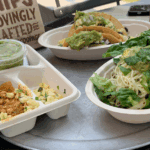Your burrito bowl could be more than just lunch; it might be influencing your digestion and your breakouts. If you’ve ever left Chipotle feeling a little bloated or noticed your skin flaring up the next day, you’re not imagining things. What we eat has a direct impact on our gut health, and in turn, our skin.
It’s called the gut-skin axis: a powerful connection between your digestive system and your largest organ, your skin.1 When your gut is inflamed or out of balance, it can show up on your face in the form of acne, dullness, or dryness.1 And with heart health, immune strength, and even mental clarity linked to your microbiome, the choices we make at places like Chipotle matter more than ever.
Here’s how to build a better bowl that works with your body, not against it.
The Gut-Skin Connection: More Than a Trend
Your gut is home to trillions of bacteria: some good, some not-so-good. When the healthy bacteria (your microbiome) thrive, they support strong digestion, reduce inflammation, and help regulate your immune system.1 But when your gut gets out of balance, that inflammation can travel through your bloodstream and show up in places like your skin.
Recent studies show that people with skin issues like acne or eczema often have altered gut microbiomes compared to people with clear skin. And chronic digestive issues like bloating, constipation, or “leaky gut” are often linked to dietary triggers that also aggravate the skin.1
This makes your lunch choices an important part of your health strategy, not just for your digestion, but for how you feel and look overall.
How to Build a Gut- and Skin-Friendly Chipotle Bowl
- Double Up on Fajita Veggies
Peppers and onions aren’t just colorful, they’re packed with vitamin C, antioxidants, and fiber.2 Fiber fuels beneficial gut bacteria, keeping your digestion smooth and supporting a strong intestinal lining.2 Antioxidants help neutralize free radicals, reducing skin inflammation and supporting collagen production for clearer, firmer skin.3 - Choose Chicken or Sofritas Over Heavier Meats
While carnitas and barbacoa may be flavorful, they’re also higher in saturated fats, which can fuel inflammation.4 Opting for grilled chicken or sofritas (a tofu-based protein) gives you high-quality protein without the extra saturated fat. Diets lower in saturated fat are linked to better skin clarity and more diverse gut microbiomes.1 - Skip or Go Light on Cheese and Sour Cream
For many people, especially in Black and Brown communities, lactose intolerance is common.5 Dairy can contribute to bloating, gas, and in some cases, acne.6 This is due in part to how dairy influences insulin-like growth factor 1 (IGF-1), a hormone that may increase oil production in the skin.6 If you love creamy textures, guacamole is a heart-healthy, skin-nourishing alternative. - Watch the Chips and Queso
It’s easy to turn a healthy bowl into a salty, fried feast with a side of chips and queso. These items are often high in sodium, refined carbs, and saturated fats, all of which can spike inflammation. Too much sodium also dehydrates the skin and puts pressure on your cardiovascular system, leading to fluid retention and puffiness.7 - Be Mindful With Beans and Brown Rice
Both beans and brown rice are excellent sources of fiber, magnesium, and B vitamins, which support healthy skin and energy production.4 But if you’re not used to high-fiber foods, large portions can lead to bloating. Start with half portions and drink plenty of water to support digestion.
Opt For Food That Loves You Back
You don’t need to give up your Chipotle habit to feel better. By making small, intentional swaps, you can build a meal that fuels your body, supports your skin, and keeps your gut microbiome thriving. Over time, these choices can lead to fewer breakouts, more regular digestion, and even improved mental clarity.
Because when you feel good inside, it shows on the outside.
References
- De Pessemier, B., Grine, L., Debaere, M., Maes, A., Paetzold, B., & Callewaert, C. (2021). Gut–Skin Axis: Current Knowledge of the Interrelationship between Microbial Dysbiosis and Skin Conditions. Microorganisms.doi: 10.3390/microorganisms9020353
- Lui, N. (2025, February 17). The 9 Best High-Fiber Vegetables You Should Be Eating, According to a Dietitian. Retrieved from EatingWell : https://www.eatingwell.com/article/8044305/best-high-fiber-vegetables/
- Arnarson, A. (2023, July 12). Antioxidants Explained in Simple Terms. Retrieved from Healthline: https://www.healthline.com/nutrition/antioxidants-explained
- Brownstein, A. (2025, May 2). Is Chipotle Healthy? Your Guide to Making Smarter Fast Food Choices. Retrieved from Season: https://www.seasonhealth.com/blog/is-chipotle-healthy
- SNMA. (2024, September 24). Fortifying Our Health: The Role of Dairy in Black Americans’ Diets . Retrieved from Student National Medical Association (SNMA): https://snma.org/news/678390/Fortifying-Our-Health-The-Role-of-Dairy-in-Black-Americans-Diets-.htm
- Watson, K. (2024, July 31). Is There a Link Between Dairy and Acne? Retrieved from Healthline: https://www.healthline.com/health/dairy-and-acne
- Cleveland Clinic. (2020, December 2). How Salt Can Impact Your Blood Pressure, Heart and Kidneys. Retrieved from Cleveland Clinic: https://health.clevelandclinic.org/kidneys-salt-and-blood-pressure-you-need-a-delicate-balance









